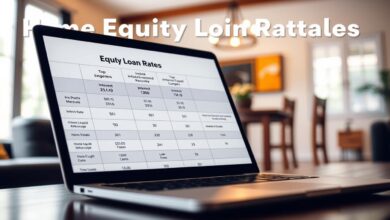Consolidation Loans: Combine Debt into One Simple Payment
Juggling multiple bills each month? You’re not alone. Many Americans find themselves overwhelmed by due dates, varying interest rates, and confusing payment schedules. What if you could replace that financial chaos with one predictable monthly payment? That’s where strategic debt management solutions shine.
This approach isn’t just about convenience—it’s a powerful way to regain control of your finances. By combining what you owe into a single plan, you could lower your overall interest costs and simplify your budgeting process. While personal loans are a common tool, other strategies like balance transfers or credit counseling programs might better suit your situation.
We’ll explore how these methods work, their pros and cons, and how to choose the right path for your goals. Whether you’re dealing with credit card balances, medical bills, or other obligations, there’s a way to create breathing room in your budget.
Key Takeaways
- Simplify multiple payments into one manageable monthly obligation
- Potentially reduce interest rates and total repayment costs
- Explore strategies beyond traditional lending products
- Tailor solutions to your specific financial circumstances
- Prioritize methods that align with long-term money goals
- Compare options from banks, credit unions, and certified agencies
Understanding Debt Consolidation and Its Benefits
Handling numerous debts simultaneously creates unnecessary stress. Debt consolidation offers a structured way to manage what you owe by combining balances into one predictable plan. This method helps you focus on progress rather than payment chaos.
What Debt Consolidation Means for Your Finances
This strategy transforms financial management. Instead of tracking five credit cards or medical bills, you handle one responsibility. Fewer due dates mean fewer chances to miss payments, which protects your credit history.
Most people save money through lower interest rates. For example, credit cards often charge 18-25% APR. A consolidated plan might cut this to 9-15%, letting more cash tackle the actual debt.
Simplifying Multiple Payments into One
Imagine budgeting without calendar alerts for seven different bills. Single payments reduce mental clutter and account-checking time. You’ll know exactly what’s due each month—no surprises.
| Factor | Multiple Debts | Consolidated Plan |
|---|---|---|
| Payments Monthly | 5-10 | 1 |
| Due Dates | Varied | Fixed |
| Average Interest | 18-25% | 9-15% |
| Credit Impact | High Risk | Controlled |
Consistent payments show lenders you’re reliable. Over time, this can improve your credit score. Just ensure the new plan fits your budget—stretching payments too thin defeats the purpose.
What Are Consolidation Loans?
Struggling to keep up with various high-interest balances? A debt consolidation loan could streamline your financial life. These unsecured personal loans let you combine multiple obligations—like credit card balances or medical bills—into one manageable solution.
How This Financial Tool Operates
Here’s how it works: lenders provide a lump sum to pay off existing debts. You then repay this single new credit account over time. Most options feature fixed rates and set timelines, making monthly budgeting predictable.
“The real power lies in securing a lower interest rate than your current debts,” explains a financial advisor from a major U.S. bank. This rate difference determines whether you save money long-term.
| Factor | Before | After |
|---|---|---|
| Number of Payments | Multiple | One |
| Interest Rates | 18-29% (variable) | 6-15% (fixed) |
| Repayment Terms | Mixed deadlines | Clear timeline |
| Credit Impact | Multiple inquiries | Single account |
While this approach simplifies payments, remember—you’re swapping several creditors for one lender. Timely payments become crucial. Miss them, and you risk damaging your credit score further.
Always compare offers from banks and credit unions. Look beyond interest rates—consider fees, repayment flexibility, and customer service quality. The right fit depends on your unique financial picture.
Exploring Different Debt Consolidation Options
Managing multiple financial obligations can feel like solving a puzzle with missing pieces. Several strategies exist to simplify repayment, each suited to different debt levels and personal circumstances. Let’s break down popular methods to help you find the right fit.
Personal Loans, Lines of Credit, and Balance Transfers
Fixed-rate personal loans offer predictable payments over 2-7 years, ideal for debts under $25,000. Balance transfer cards work best for smaller amounts (up to $5,000) with promotional 0% APR periods—just watch out for post-promo rate spikes.
Personal lines of credit provide flexible access to funds, perfect for ongoing expenses. However, they require discipline since available credit replenishes as you repay. “These tools work best for organized borrowers who track spending closely,” notes a certified financial planner.
Comparing Unsecured Versus Secured Methods
Unsecured options don’t require collateral but often have higher rates. Secured methods like home equity products use your property as backing, offering lower rates but greater risk. Consider these factors:
| Feature | Unsecured | Secured |
|---|---|---|
| Collateral Needed | No | Yes (e.g., home) |
| Interest Rates | 6-25% | 3-10% |
| Risk Level | Lower | Higher |
| Debt Capacity | Up to $30k | Up to home equity limit |
Debt management plans stand out for larger balances. Nonprofit agencies negotiate with creditors to lower rates without new borrowing. This approach avoids collateral risks but requires strict payment adherence.
Assessing Your Financial Situation for Consolidation
Feeling buried under a mountain of bills? Start by mapping your financial landscape. A clear picture of income versus expenses reveals what you can realistically put toward payments each month. This groundwork helps determine if combining obligations makes sense for your unique situation.
Building Your Financial Blueprint
Track every dollar for 30 days—fixed costs like rent, variable expenses like groceries, and surprise charges. Compare this total to your take-home pay. If expenses exceed income, prioritize adjustments before considering consolidation strategies.
| Category | Monthly Income | Monthly Expenses |
|---|---|---|
| Amount | $4,500 | $4,200 |
| Difference | $300 available for debt payments | |
List all existing balances with current rates and minimum payments. Credit cards at 24% APR? Medical bills in collections? Knowing these details helps identify which debts cost you the most. Calculate your debt-to-income ratio: total monthly payments divided by gross income. Lenders prefer ratios under 36%.
Review your credit report for errors impacting your score. A 650+ rating typically qualifies for better terms. “Understanding your starting point prevents unrealistic expectations,” advises a financial coach from a Texas-based nonprofit.
Finally, identify what caused the debt buildup—emergency costs or overspending? Create guardrails like automatic savings transfers to avoid repeating patterns. Set milestones: “Pay off $8,000 in 18 months” works better than vague goals.
Qualifying for a Debt Consolidation Loan
Getting approved for financial relief requires meeting specific criteria. Lenders evaluate three key factors: your credit history, income stability, and existing obligations. Let’s break down what you need to secure favorable terms.
Credit Score and Income Considerations
Most banks want to see a credit score of 660 or higher for their best rates. This number shows how reliably you’ve managed past debts. Applicants with scores below this threshold might face higher interest rates or need co-signers.
Lenders also verify income through pay stubs or tax returns. They look for consistent earnings that comfortably cover the new payment plus living expenses. Self-employed individuals may need to provide 2+ years of tax documents.
Debt-to-Income Ratio Requirements
Your debt-to-income (DTI) ratio plays a crucial role. Financial institutions typically require this percentage to stay under 36%. Calculate yours by dividing total monthly debt payments by gross monthly income.
| Approval Factor | Ideal Range | Risk Zone |
|---|---|---|
| Credit Score | 660+ | Below 580 |
| DTI Ratio | Under 36% | Over 50% |
| Income Verification | Stable | Irregular |
Recent regulatory changes have made approvals tougher. Some lenders now demand scores above 680 and DTIs below 33%. If you don’t qualify, consider credit unions or nonprofit counseling agencies. These alternatives often have more flexible requirements.
To boost eligibility: pay down small balances first, dispute credit report errors, and avoid new credit applications. Improving your financial profile takes time, but each positive step increases approval odds.
Comparing Interest Rates and Terms
Choosing between financial solutions feels like picking between two doors—each leads to different outcomes. Understanding rate structures helps you select the path that saves money and aligns with your repayment timeline.
Fixed Rates vs. Temporary Promotions
Fixed-rate options lock in predictable payments for years. These work well for those prioritizing stability. You’ll know exactly what you owe each month, making budgeting straightforward.
Promotional rates on balance transfer cards offer short-term relief. Many start at 0% APR for 6-18 months. But watch the clock—rates often jump to 18-29% after the intro period. “These deals only pay off if you clear the balance before the deadline,” warns a Bankrate analyst.
| Factor | Fixed Rates | Promotional Rates |
|---|---|---|
| Rate Type | Stable | Temporary |
| Duration | 2-7 years | 6-18 months |
| Average Fees | 1-5% origination | 3-5% transfer fee |
| Best For | Long-term planning | Quick payoff plans |
Current market conditions favor borrowers. The Federal Reserve’s rate adjustments have kept borrowing costs competitive. Creditworthy individuals can secure rates under 10%—a historic advantage.
Always calculate total costs. A 3% balance transfer fee adds $300 to a $10,000 debt. Compare this to a loan with a 5% origination fee but lower long-term interest. Use online calculators to model different scenarios before deciding.
Strategies for Choosing the Right Consolidation Loan
Navigating financial solutions requires a sharp eye for detail. Start by requesting estimates from multiple lenders—banks, credit unions, and online providers. Compare the total repayment amount, not just monthly payments. A lower rate might hide higher fees or extended timelines.
Create a spreadsheet to track offers. Include columns for:
- Annual Percentage Rate (APR)
- Origination fees (typically 1-8% of the loan)
- Prepayment penalties
- Loan duration (2-7 years)
“Focus on the lifetime cost,” advises a financial educator from NerdWallet. “A $15,000 debt at 7% over five years costs $2,800 in interest. At 10%, it jumps to $4,100.”
| Factor | Short-Term Loan | Long-Term Loan |
|---|---|---|
| Monthly Payment | $450 | $250 |
| Total Interest | $1,200 | $3,000 |
| Flexibility | Less budget strain | More cash flow |
Time your applications wisely. Credit bureaus usually count multiple inquiries within 14-45 days as one event. This lets you shop rates without tanking your score.
Finally, match the repayment timeline to your goals. Can you handle higher payments to save $1,800 in interest? Or do you need lower installments to avoid missed payments? Your budget holds the answer.
Budgeting and Planning for One Monthly Payment
Creating a clear financial roadmap becomes essential when transitioning to a single payment strategy. Start by listing all income sources and fixed expenses like housing and utilities. This foundation helps determine how much you can allocate to your new financial plan while covering necessities.
Steps to Create an Effective Budget
Begin with a 50/30/20 framework: 50% for needs, 30% for wants, and 20% for savings and payments. Track every coffee purchase and streaming subscription for 30 days—you’ll spot patterns quickly. Apps like Mint or spreadsheets can automate this process.
Build an emergency fund with at least $500 initially. This cushion prevents unexpected car repairs or medical bills from derailing your progress. “Small savings buffers reduce reliance on credit cards by 63%,” according to a Federal Reserve report.
| Category | Monthly Allocation | Actual Spending |
|---|---|---|
| Groceries | $400 | $420 |
| Entertainment | $150 | $210 |
| Debt Payment | $300 | $300 |
Managing Your Cash Flow
Set up automatic transfers for bills and savings right after payday. This “pay yourself first” approach ensures priorities get funded before discretionary spending. Review bank statements monthly to identify areas for adjustment.
Plan for irregular expenses by dividing annual costs into monthly savings. For example, a $600 insurance premium becomes a $50 monthly line item. Avoid new credit card charges by using cash for discretionary purchases—physical money feels more “real” than plastic.
Celebrate small wins like sticking to your grocery budget or adding $50 to savings. These milestones keep motivation high during your financial transformation.
Working with Credit Counsellors and Professionals
Navigating financial challenges alone can feel overwhelming, but expert guidance exists to lighten the load. Certified credit counsellors offer personalized strategies to help you regain control without judgment. These professionals focus on creating sustainable solutions rather than quick fixes.
The Role of Credit Counselling in Debt Management
Nonprofit credit counselling agencies provide a free financial checkup to assess your situation. A trained counsellor reviews your income, expenses, and obligations to identify patterns. They’ll explain options like debt management programs or budgeting adjustments tailored to your circumstances.
During consultations, expect detailed analysis of:
- Current interest rates and fees
- Realistic payment timelines
- Potential savings through negotiated rates
Benefits of a Debt Management Program
These programs simplify repayment through single monthly deposits handled by your counsellor. Agencies work directly with creditors to potentially lower rates or waive fees. Unlike traditional approaches, there’s no new borrowing—just restructured payment terms.
Key advantages include:
- Consolidated payments without loan applications
- Professional negotiation with lenders
- Educational resources for long-term stability
Reputable organizations like the National Foundation for Credit Counseling (NFCC) uphold strict ethical standards. Their services prioritize your financial health over profits, making them ideal for those seeking trustworthy guidance.








